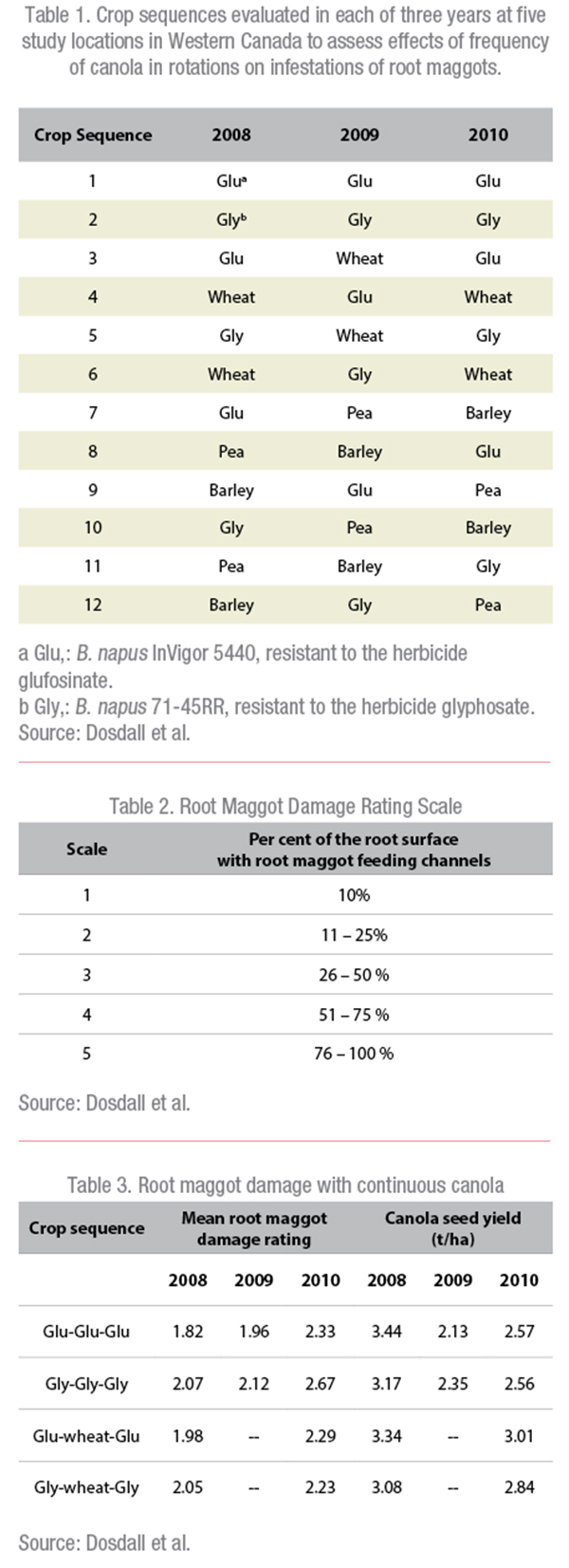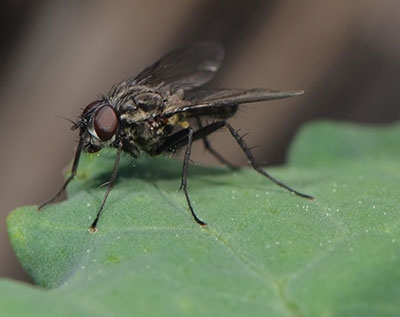
Features
Agronomy
Corn
Root maggot thrives under tight rotations
Here’s another knock against tight rotations. A research study in Western Canada found that when canola is grown continuously, root maggot damage increases on canola taproots. The costs, while not necessarily attributable to root maggot damage alone, ranged from $53 to $71 per acre.
“This study has shown that three consecutive years of canola production results in a buildup of root maggot infestations,” says professor and entomologist Lloyd Dosdall at the University of Alberta at Edmonton. Dosdall was the lead researcher on a team that included Neil Harker, John O’Donovan, Bob Blackshaw, Eric Johnson and Yantai Gan of Agriculture and Agri-Food Canada, and Randy Kutcher at the University of Saskatchewan.
The research was conducted from 2008 through 2010, and was recently published in the Journal of Economic Entomology by the Entomological Society of America in 2012. In the trial, 10 different crop sequences were evaluated over three years at five locations in Western Canada: Lacombe and Lethbridge, Alta., and Melfort, Swift Current and Scott, Sask. (Table 1).
Canola was seeded at 20- to 30-cm row spacing at a depth of 1 cm using a Conserva Pak no-till drill equipped with knife openers. Fertilizer was applied according to soil test recommendations. Root maggot damage on canola roots was assessed immediately after harvest by using the root maggot rating scale that Dosdall developed in 1994 (Table 2).
“There is a relationship between root maggot damage and yield loss. In another study conducted at the Lacombe site, we determined that canola yield declined by 192 kg/ha (3.4 bu/ac) for each unit increase in root maggot damage rating. A mean damage rating of 3.5 would then correlate to a yield loss of 672 kg/ha (12 bu/ac),” explains Dosdall.
Doing the math, that damage rating of 3.5 would result in a 12 bu/ac loss or around $120 per acre. In Western Canada, root maggot infestations and damage are the greatest in the northern and central Alberta regions, and in the Parkland regions of Saskatchewan and Manitoba. No insecticides are available for control, and canola seed treatments for flea beetles do not provide effective control. Brassica rapa varieties are more susceptible to root maggot injury than are B. napus varieties.
Root maggot damage increased with continuous canola
In the trial, root maggot damage increased in each year of the study on continuous canola. The three-year continuous canola rotation showed a progressive increase in root maggot damage each year (Table 3).
“This study has shown that three consecutive years of canola production results in a buildup of root maggot infestations, but not two consecutive years of production in the same field,” says Dosdall.
Looking at yield, analysis showed that the three-year continuous canola suffered yield losses compared to the two-year rotation where canola was rotated with a different crop in 2009. In 2010, the continuous glufosinate canola yielded 0.44 t/ha (7.8 bu/ac) less than the two-year rotation. In addition, the glu-wheat-glu rotation yielded 0.46 t/ha (8.2 bu/ac) less in 2010 than the pea-barley-glu rotation. Comparing the three-year canola glufosinate rotation to the pea-barley-glu rotation, the 2010 yield of continuous glufosinate canola was 0.9 t/ha (16 bu/ac) less.
Similar trends were observed with the glyphosate canola rotations.
Dosdall explains that not all yield losses were necessarily due to root maggot damage. Plant diseases such as blackleg and sclerotinia also increase under tight rotations and could have caused some yield loss.
In the study, the glufosinate-resistant LibertyLink variety, InVigor 5440, showed less root damage than the glyphosate-resistant Roundup Ready variety, 71-45RR. However, Dosdall cautions that this does not mean glufosinate-resistant varieties are more resistant to root maggot.
“I have done quite a few studies on root maggots over the years, and one consistent result is that canola varieties (and species) differ in their susceptibilities to attack by these pests. In this study, we found that the glyphosate-tolerant variety (71-45RR) was more susceptible to attack than the glufosinate-tolerant variety (InVigor 5440). However, there is no evidence from this study or any others I’ve done that all glufosinate-tolerant varieties are more resistant to attack than all glyphosate-tolerant varieties,” explains Dosdall.
Overall, the average yield reductions in continuous canola for three years average 0.3 to 0.4 t/ha (5.3 to 7.1 bu/ac) less than canola grown in rotation. This loss is estimated at approximately $53 to $71 per acre at $10 per bushel canola. More evidence that short canola rotations are detrimental to the bottom line.
 |
November 25, 2013 By Bruce Barker
 When canola is grown continuously A research study in Western Canada found that when canola is grown continuously
When canola is grown continuously A research study in Western Canada found that when canola is grown continuously